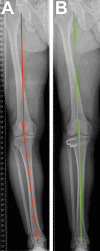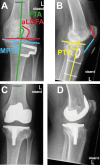Total knee arthroplasty following lateral closing-wedge high tibial osteotomy versus primary total knee arthroplasty: a propensity score matching study
- PMID: 38715064
- PMCID: PMC11077886
- DOI: 10.1186/s13018-024-04760-6
Total knee arthroplasty following lateral closing-wedge high tibial osteotomy versus primary total knee arthroplasty: a propensity score matching study
Abstract
Background: The disparity in patient-reported outcomes between total knee arthroplasty (TKA) following high tibial osteotomy (HTO) and primary TKA has yet to be fully comprehended. This study aims to compare the patient-reported outcomes, radiological parameters and complication rates between TKA following HTO and primary TKA.
Methods: Sixty-five patients who underwent TKA following lateral closing-wedge HTO were compared to a matched group of primary TKA at postoperative 6-months and 1-year. Between-group confounders of age, gender, smoking status, Body Mass index, preoperative Numeric Rating Scale (NRS) pain in rest, Knee injury and Osteoarthritis Outcome Score-Physical function Shortform (KOOS-PS), EuroQol five-dimensional (EQ-5D) overall health score, and Oxford Knee Score (OKS) were balanced by propensity score matching. Patient-reported outcome measures were NRS pain in rest, KOOS-PS, EQ-5D overall health score, and OKS. Radiological parameters were femorotibial angle, medial proximal tibial angle, anatomical lateral distal femoral angle, posterior tibial slope, and patellar height assessed by Insall-Salvati ratio. The complication rates of TKA were compared between the two groups. The HTO survival time, the choice of staple removal before or during TKA in patients who underwent TKA following HTO patients, and the rate of patellar resurfacing were assessed. The p value < 0.0125 indicates statistical significance after Bonferroni correction.
Results: After propensity score matching, no significant between-group differences in the patient-reported outcome measures, radiographical parameters and complication rates were found (p > 0.0125). In the TKA following HTO group, with an average HTO survival time of 8.7 years, staples were removed before TKA in 46 patients (71%) and during TKA in 19 patients, and 11 cases (17%) had patella resurfacing. In the primary TKA group, 15 cases (23%) had patella resurfacing.
Conclusion: The short-term assessment of TKA following HTO indicates outcomes similar to primary TKA. A previous HTO does not impact the early results of subsequent TKA, suggesting that the previous HTO has minimal influence on TKA outcomes.
Level of evidence: III, cohort study.
Keywords: High tibial osteotomy; Patient-reported outcomes; Propensity score match; Radiological results; Total knee arthroplasty.
© 2024. The Author(s).
Conflict of interest statement
The authors declare they have no conflict of interest.
Figures




Similar articles
-
Total knee arthroplasty after prior high tibial osteotomy results in comparable survival and clinical outcomes but significantly higher complication rates compared to primary total knee arthroplasty: a systematic review and meta-analysis of 550,000 patients.Eur J Orthop Surg Traumatol. 2025 Mar 17;35(1):119. doi: 10.1007/s00590-025-04237-0. Eur J Orthop Surg Traumatol. 2025. PMID: 40095117
-
TKA following high tibial osteotomy versus primary TKA--a matched pair analysis.BMC Musculoskelet Disord. 2010 Sep 14;11:207. doi: 10.1186/1471-2474-11-207. BMC Musculoskelet Disord. 2010. PMID: 20840744 Free PMC article.
-
Similar short-term KOOS between open-wedge high tibial osteotomy and total knee arthroplasty in patients over age 60: A propensity score-matched cohort study.Mod Rheumatol. 2023 Apr 13;33(3):623-628. doi: 10.1093/mr/roac052. Mod Rheumatol. 2023. PMID: 35652607
-
Total knee arthroplasty after opening- versus closing-wedge high tibial osteotomy. A 135-case series with minimum 5-year follow-up.Orthop Traumatol Surg Res. 2017 Nov;103(7):1035-1039. doi: 10.1016/j.otsr.2017.07.011. Epub 2017 Sep 6. Orthop Traumatol Surg Res. 2017. PMID: 28888524
-
Total knee arthroplasty after failed high tibial osteotomy: a systematic review of open versus closed wedge osteotomy.Knee Surg Sports Traumatol Arthrosc. 2016 Aug;24(8):2567-77. doi: 10.1007/s00167-015-3807-1. Epub 2015 Sep 30. Knee Surg Sports Traumatol Arthrosc. 2016. PMID: 26423055
Cited by
-
Total knee arthroplasty after prior high tibial osteotomy results in comparable survival and clinical outcomes but significantly higher complication rates compared to primary total knee arthroplasty: a systematic review and meta-analysis of 550,000 patients.Eur J Orthop Surg Traumatol. 2025 Mar 17;35(1):119. doi: 10.1007/s00590-025-04237-0. Eur J Orthop Surg Traumatol. 2025. PMID: 40095117
-
Mid-term outcomes of medial metal backed and all-polyethylene unicompartmental knee arthroplasty in obese patients: a retrospective propensity-matched analysis.J Orthop Surg Res. 2024 Oct 14;19(1):651. doi: 10.1186/s13018-024-05148-2. J Orthop Surg Res. 2024. PMID: 39402592 Free PMC article.
-
Lateral closing wedge high-tibial osteotomy is a long-lasting option for patients under the age of 55 with medial compartment osteoarthritis.J Exp Orthop. 2024 Oct 16;11(4):e70040. doi: 10.1002/jeo2.70040. eCollection 2024 Oct. J Exp Orthop. 2024. PMID: 39415803 Free PMC article.
References
Publication types
MeSH terms
LinkOut - more resources
Full Text Sources
Medical
Research Materials

